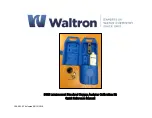
c. If a reference mass (as the 100%) is available, apply it on platform.
NOTE:
- If reference mass is not available or the reference mass will
be entered through numeric keys, then ignore this step,
d. Press
[PCENT];
e. Press [TARE] to enter,
f.
Reference mass is obtained by either one of the below: -
By applying the reference mass is applied on step c, or
In case there is no reference weight applied to platform, the last
reference mass used will be display. To confirm press [TARE]
g. This instrument is now ready for percentage calculation. Any other
weight applied to the platform will be displayed as a percentage of the
reference mass.
Press
[Weigh]
back weighing function.
6.9 ANIMAL WEIGHING FUNCTION
Follow the below steps to enter
Animal Weighing Function: -
a. select the desired weight unit,
b. If a container will be used, place this container to platform and press
[TARE]
to tare off the weight of it.
c. Press
[ANI]
to
Animal Weighing Function (Ani)
appears,
d. Now is ready to weighing animal
e. Display
Ani. AUTO INDICATOR
appears to indicator Animal Weighing
Function is in effect.
Set the Animal weighing parameter .
f.
Press [SET],
Display
RS232 ,
shift to
Animal;
Press
[TARE]
to enter
g. Display last filter (
FLt
) value applied. Select the preferred filter value
9
Animal weighing function of this instrument should not be used for trade purposes,
10
Animal weighing function does not support memory accumulation (M+) function.
11
Animal Weighing function will not operate when weight is less than 20d (or 20d
1
for dual
range).
12
It is a trade off between motion filtering and accuracy. The faster the filter, the shorter the
amount of time over which the averaging is taken. The slower the filter, the longer averaging
time will take before a reading is displayed. It is recommended that FLt 3 should be applied
first. Should situation requires, change to a lower FLt number.









































